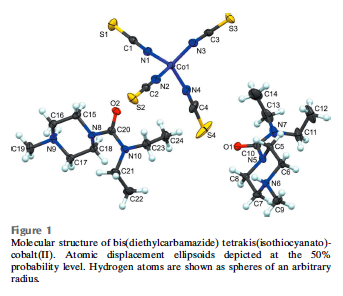
Crystal structure of the blue product produced by mixing a protonated tertiary amine, diethylcarbamazine citrate, with cobalt thiocyanate. The blue color comes from the tetrahedral [Co(NCS)4]2- di-anion, which forms a hydrophobic ion pair with the protonated tertiary amine. In this paper, we used stoichiometric quantities of cobalt and thiocyanate to form the tetrahedral di-anion, but it can also form by disproportionation of Co(SCN)2 in water.
Many other quaternary, tertiary, and bulky secondary amines give blue precipitates when mixed with Co(SCN)2. This chemistry is the basis for the Scott Test for cocaine. The formation of the [Co(NCS)4]2- di-anion depends on the pH. Low pH can protonate the thiocyanate anions and release pink aqueous Co(II) cations, which is why addition of 1M HCl in the Scott test makes the blue color turn pink. When a hydrophobic solvent such as chloroform is added and a suitable hydrophobic protonated amine is available, the Co(NCS)4]2- di-anion can reform in the organic layer, generating a blue color in the chloroform.